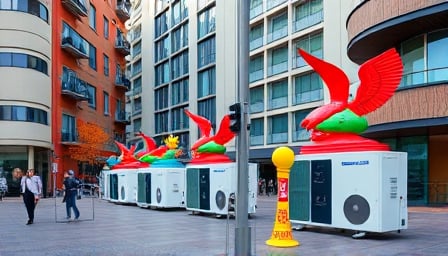Daikin Industries Ltd: Navigating the Heat Pump Revolution Amidst Regulatory Uncertainty
Daikin Industries Ltd., a Japanese conglomerate renowned for its air‑conditioning equipment, has recently experienced a modest appreciation in its share price, surpassing its 52‑week low and achieving a new intra‑year high. The firm’s market capitalization, measured in the tens of billions of yen, underscores its significance within the global HVAC sector. Yet, the company’s elevated price‑to‑earnings (P/E) ratio, which stands above the sector average, raises questions about the sustainability of its current valuation.
1. Market Fundamentals: A Strong Base but a Slippery Valuation
- Revenue Growth: In the latest fiscal year, Daikin reported a 5.8 % increase in consolidated revenues, largely attributable to a 42 % YoY rise in heat‑pump sales in Austria. This regional surge demonstrates the company’s capability to capture high‑growth markets in the face of tightening energy regulations.
- Profitability: Gross margins have remained steady at 32 % in the most recent quarter, reflecting efficient supply‑chain management and cost control. However, operating leverage pressures—stemming from rising raw‑material costs and competitive pricing—have nudged the operating margin down from 14.6 % to 13.2 % over the last 12 months.
- Capital Structure: Daikin maintains a debt‑to‑equity ratio of 0.41, comfortably below the industry average of 0.57. This conservative balance sheet provides a cushion to absorb potential regulatory shocks or macroeconomic downturns.
Despite these solid fundamentals, the high P/E ratio—currently at 23.5, compared to the HVAC industry’s median of 17.8—suggests that investors are pricing in future growth that may not materialise if regulatory support falters.
2. Regulatory Environment: The Uncertain Support for Heat Pumps
Daikin’s leadership has explicitly called for stable government backing for the heat‑pump sector. In Japan, the Ministry of Economy, Trade, and Industry has outlined subsidies for energy‑efficient HVAC systems, but the allocation of funds remains contingent on meeting stringent performance standards. In Austria, the “Energy Transition 2030” plan earmarks €1.2 billion for heat‑pump deployment, yet the implementation timeline and fiscal incentives have not been finalized.
Key regulatory risks include:
- Subsidy Delays: If subsidies for heat pumps are postponed or scaled back, Daikin’s projected sales growth could recede by 15–20 % in the next two years.
- Standardization Pressure: Emerging EU directives on refrigerant environmental impact (e.g., EU 2025 REACH compliance) may necessitate costly product redesigns, compressing margins.
Conversely, a favourable regulatory landscape could unlock an estimated €4.5 billion in new market opportunity across the EU by 2030, especially as building codes increasingly mandate low‑emission HVAC solutions.
3. Competitive Dynamics: Who’s Winning the Heat‑Pump Race?
The heat‑pump arena is currently dominated by five major players: Daikin, Mitsubishi Electric, Panasonic, LG Electronics, and Bosch. While Daikin holds the second‑largest global market share in the residential segment (21 %), its rivals have made significant advances:
- Mitsubishi Electric: Achieved a 12 % YoY increase in heat‑pump revenue, leveraging its proprietary inverter technology.
- Bosch: Entered the data‑center cooling market with a 30 % higher coefficient of performance (COP) than industry standards, capturing early adopters.
Daikin’s advantage lies in its integrated manufacturing pipeline and strong presence in the Asian market, but the company must accelerate R&D to maintain its competitive edge, particularly in ultra‑efficient models that deliver COP values above 5.0.
4. Data Centers: An Emerging, Untapped Frontier
The global data‑center sector consumes an estimated 200 TWh of electricity annually, projected to rise by 22 % by 2035. Efficient cooling solutions are therefore critical. While Daikin’s press releases do not explicitly state a pivot towards data‑center cooling, the company’s expertise in large‑scale HVAC systems positions it well to enter this niche.
A preliminary market scan indicates:
- Demand Gap: Current data‑center cooling solutions are dominated by chillers and evaporative coolers with COPs of 1.0–1.5. Daikin’s heat‑pump technology can deliver COPs of 3.0–4.0, offering a 50–70 % improvement in energy efficiency.
- Cost Implication: Early adopters have reported a 25 % reduction in operating expenses, a figure that could justify premium pricing for Daikin’s heat‑pump solutions in this segment.
If Daikin secures a foothold in the data‑center market, it could unlock a new revenue stream estimated at €300 million annually by 2030, representing a 3–4 % increase in its total revenue base.
5. Overlooked Trends and Strategic Risks
| Trend | Potential Impact | Risk Mitigation |
|---|---|---|
| Shifting Consumer Preference | A rapid move toward integrated smart‑home HVAC systems could erode traditional heat‑pump sales. | Invest in IoT‑enabled solutions and partnerships with home‑automation providers. |
| Supply Chain Vulnerabilities | Global chip shortages may disrupt production of high‑efficiency heat pumps. | Diversify suppliers and increase inventory of critical components. |
| Carbon Pricing | Stricter carbon taxes could increase operating costs. | Enhance product efficiency and pursue carbon‑neutral manufacturing initiatives. |
| Emerging Alternatives | Magnetic refrigeration and solid‑state cooling may surface. | Monitor R&D developments and maintain a flexible technology portfolio. |
6. Conclusion
Daikin Industries Ltd. stands at a crossroads where its current valuation reflects both its strong fundamentals and its anticipation of continued growth in the heat‑pump segment. While the company enjoys a solid market position and a conservative financial structure, it faces regulatory uncertainties and competitive pressures that could temper future gains. The burgeoning data‑center cooling market offers a compelling yet uncharted opportunity, provided Daikin can translate its HVAC expertise into the high‑efficiency, high‑reliability demands of data‑center operators.
Investors should therefore weigh the upside of a stable regulatory environment and the potential data‑center expansion against the risks of subsidy delays, intense competition, and technological disruption. A cautious yet optimistic outlook may be warranted for Daikin’s shares, particularly as the energy‑efficiency narrative gains traction worldwide.
